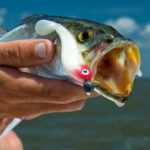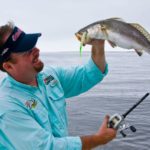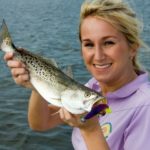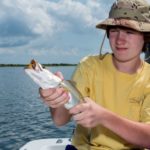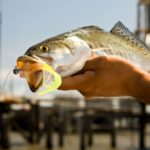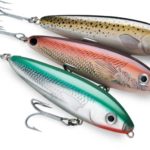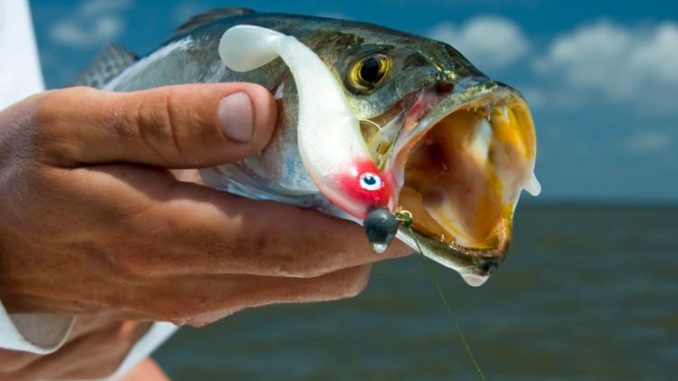
Trout not cooperating? Get on the big motor and get back on the bite.
Capt. Lane Zimmer’s text message was crystal clear.
“… left them biting yesterday,” the message read.
I wasn’t sure what happened between yesterday and this morning, but Lane’s spot that was so productive just 24 hours before only gave up two trout.
“Lines in,” he directed. “They may not be here today, but they’ve got to be somewhere. We’ve just got to find them.”
The plan that we were about to implement wasn’t anything new to Zimmer.
“Every summer it’s the same thing,” he said as he shut down his big motor well away from the few pilings that remain from the old Manilla Village shrimp-drying platforms.
Fortunately for us, the 10 boats Zimmer expected to already be there were no where around. We had the spot all to ourselves.
Unfortunately for us, the pilings only surrendered another couple trout.
Seventy one fish shy of a 3-man limit, Zimmer elaborated on his plan for catching summer trout between Lafitte and Grand Isle.
“At this rate, we’d have to fish nearly 40 spots to get a limit,” he chuckled as he again directed my son and me to pull in our lines. “Hopefully we’ll find more than two fish at the next spot. If not, we’re just going to have to keep searching until we find them stacked up.”
In a nut shell Zimmer’s plan for summer trout fishing is to search multiple spots throughout Barataria Bay until he finds a one or two where he can destroy the trout before the dolphins destroy the spot.
While slipping in to the north side of a broken island, Zimmer voiced his displeasure with our lack of tide.
“Man, the water’s not moving at all,” he noted while watching his popping cork sit idle beside a patch of grass that hardly gave the first clue at what lay underneath the water.
His cork went down seconds later. Then mine went down. My son’s disappeared too.
In the brief mayhem that ensued, all three of us stayed busy weeding through some popcorn trout to add a few keepers to the box before the tell-tale audible sounds of approaching dolphin — a puffing and wheezing sound reminiscent of something one might hear while watching television’s “The Biggest Loser.”
“That’s it. We’re done here,” Zimmer insisted while watching the mother and baby duo circle his boat taking advantage of some stunned 11 ½-inch trout that had to go back in the water.
“Since we don’t have any water moving, we’re going to have to spend a lot more time looking for fish today,” Zimmer continued while idling away from the broken island.
The basic rule of thumb for summer fishing in Barataria Bay is the more the water is moving the less anglers have to search. The less the water is moving the more anglers have to search.
“What I really like to do is fish my way toward Grand Isle while the tide is coming in during the morning,” Zimmer said. “We’ll lay over and grab a sandwich on the island waiting for the tide to turn. Then we fish the falling tide all the way back north.”
With no tide moving, there were no sandwich breaks in our future because we were going to have to work straight through lunch just to find groups of trout that could send Zimmer’s fish counter spinning.
Our next stop was a small oyster reef that was readily apparent from all the poles sticking above the water.
“They’re going to be on one of the corners of this reef,” Zimmer said. “If the tide was moving, we could do to the corners on the down-current side, but with no tide, we’re going to have to fish them all to figure out where they are. And they could be on all the corners.”
We struck silver the first corner we fished. Our corks went under with amazing regularity, and we all three slung trout after trout over the side of Zimmer’s boat.
“Can’t believe the dolphin haven’t showed up,” I innocently said as I added another trout to the box.
“I can’t believe you said the D word,” Zimmer scolded. “Now they’re gonna come running. They have learned that sound of a popping cork splashing on the surface means some easy meals. But we sure don’t want to ruin a good thing by calling them by name.”
Three or four fish later, we heard the wheezing puff of dolphin closing the distance. The trout bite died instantly.
“Guess that’s it for this spot, too,” Zimmer laughed as he pulled up his trolling motor. “We gotta keep moving.”
Our next stop had me questioning if the sun had done a number on Zimmer. He stopped running smack dab in the middle of a bay with no sign of anything worth fishing.
“You’re not the only one,” he responded. “I had a guy stop by me one day while I was fishing this spot to ask me if I needed any help. He thought I was broken down. I thanked him for checking on me but told him I was just fishing.”
It didn’t take too long for me to realize why Zimmer stopped here. Although it didn’t look like anything but open water at the surface, down below was a sunken island that held a lot of trout.
As we plucked trout after trout from the spot, a passing boat slowed in the distance.
“You want to educate him?” I asked.
“Nah. We can cast, but don’t work your corks. If they go down, just let them go until he passes,” Zimmer instructed.
We continued to add a few small trout to be box as we watched the boat fade into the distance; however, I couldn’t get it out of my mind that Zimmer, while throwing a topwater at our first stop, had told me that he had a pocket closer to Grand Isle that he was confident would give up some 20-inch trout.
“About that Skitterwalk,” I reminded him. “When we going to get to that spot?”
That was all the goading Zimmer needed. We headed toward the pocket that was just to the northwest of Caminada Pass.
It looked like a redfish hole, but it was some of the prettiest water we had seen all day long.
I started working my popping cork toward the open water while my son covered the bank side. Zimmer immediately grabbed his topwater rod.
Almost instantly, Zimmer had a blow up and my son pulled a nice trout into the boat. Since I wasn’t doing anything but hauling water out the other side, I turned to join in on the action.
Although we were catching a few nice trout, Zimmer kept talking about what lay just around the point.
“It’s been full of mullet in there,” he said. “That’s where the good trout have been, and that’s where the topwater bite has been the best.”
Sure enough, as soon as we could see the other side of the point it was evident that the mullet were still around. The trout crashing Zimmer’s Rapala Skitterwalk confirmed that they were still there, too.”
Zimmer said this nondescript pocket typically held big trout because where the pocket kind of bends to the right there is a canal that comes out behind it.
“When the water pulls through that canal the trout like to stack up here and attack the mullet that come out with the water,” he went on. “All that water pulling out of the canal crosses this shallow flat and the big trout just love it… not too many fish but big fish. And it’s a great place to throw topwater.”
After the topwater action dried up, we headed to Coupe Abel Pass to fish the sand bars. There was another boat already there catching a few fish, but we came up empty handed.
“They got a new artificial reel at Independence Island,” Zimmer announced as he instructed us to pull in our lines once again. “I got on them pretty good there the other day. Let’s go see if they’re still there.”
Coming off plane, I was reminded of being in Saudi Arabia during Desert Storm. Of all the spots in the desert, I never could figure out how our company knew we were at the right one because everything looked the same.
The open water was very similar. Were we just going to pick a spot and start praying we stopped at the right one, or did Zimmer know something I didn’t?
“We fish a lot of spots that used to be here,” Zimmer laughed as he started trying to explain. “But just because you can’t see anything above the water anymore doesn’t mean all that good stuff under the water is gone, too. The islands may not be there now, but all the shells and oysters are there. If you know where the old islands were, you can still fish them.”
Even though he knew we were on the right spot, Zimmer had us start fan-casting the area because he didn’t know specifically where the fish would be stacked up.
It didn’t take long for our corks to start disappearing beneath the water, but it also didn’t take long for the bite to suddenly stop.
“The fish haven’t stopped biting,” Zimmer said. “We probably drifted off our mark, or they may be moving around a little bit. Keep casting and we’ll find them again.”
Sure enough, over the next hour or so we would get into flurries of fish when we could catch one just about every cast. Then we would hit a dry spell when we couldn’t buy a bite until we figured out how to line the boat up again to get back on them.
By the end of the day we had a nice limit of trout to take back to the cleaning table.
“It can be frustrating sometimes because where you caught them yesterday they may not be there today,” Zimmer said as we pulled back up to the marina. “But you can bet that somewhere between Lafitte and Grand Isle you can find a pile of fish. As long as you’re willing to put in the time and effort to find them every day, you can keep trout fillets in your freezer all summer long.”
At certain points during the day, this trip felt more like work than it did fishing, but that’s what fishing Barataria Bay is like during the summer — work.
But as the old saying goes — work has its rewards.
